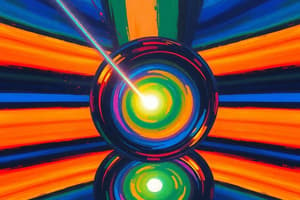Podcast
Questions and Answers
किस नियम के अनुसार, जब एक किरण प्रकाश सतह पर परावर्तित होती है, तो प्रकाश की आपति का कोण उसके परावर्तन के कोण के बराबर होता है?
किस नियम के अनुसार, जब एक किरण प्रकाश सतह पर परावर्तित होती है, तो प्रकाश की आपति का कोण उसके परावर्तन के कोण के बराबर होता है?
- परावर्तन का नियम उसके प्रकाश की आपति के बराबर
- प्रकाश परावर्तन का नियम
- प्रकाश का नियम (correct)
- प्रकाश परावर्तन समतुलय का नियम
विस्तारित प्रकाशन के लिए परावर्तन के किस नियम का संदेश देता है?
विस्तारित प्रकाशन के लिए परावर्तन के किस नियम का संदेश देता है?
- प्रकाश की आवृत्ति होती है
- प्रकाश एकत्रित होता है
- प्रकाश समतुल्य होता है
- प्रकाश परावर्तन की आपति समतुल्य होती है (correct)
कौन-सा प्रकार के परावर्तन से हम मंद चमकदार वस्तुओं को देख सकते हैं?
कौन-सा प्रकार के परावर्तन से हम मंद चमकदार वस्तुओं को देख सकते हैं?
- संपूर्ण प्रकाशन
- विस्तारित प्रकाशन (correct)
- लहरी प्रकाशन
- समतुल्य प्रकाशन
प्रकाश के परावर्तन के लिए सम्मेलन में उल्लेखित 2 मुख्य नियमों की संख्या क्या है?
प्रकाश के परावर्तन के लिए सम्मेलन में उल्लेखित 2 मुख्य नियमों की संख्या क्या है?
प्रकाशन प्रक्रिया में समतुल्य प्रकाशन की संभावना कहाँ होती है?
प्रकाशन प्रक्रिया में समतुल्य प्रकाशन की संभावना कहाँ होती है?
किस कारण आवश्यकता है कि हम अपनी प्रतिबिम्ब देख सकें?
किस कारण आवश्यकता है कि हम अपनी प्रतिबिम्ब देख सकें?
बड़े दर्पण कैसे उपयोगी होते हैं?
बड़े दर्पण कैसे उपयोगी होते हैं?
प्रकाश का कौन-सा सिद्धांत ऑप्टिकल इल्यूजन की समझ में मदद करता है?
प्रकाश का कौन-सा सिद्धांत ऑप्टिकल इल्यूजन की समझ में मदद करता है?
प्रकाश के साथ सतहों से कैसे प्रतिक्रिया होती है?
प्रकाश के साथ सतहों से कैसे प्रतिक्रिया होती है?
धूल से प्रकाश की प्रतिक्रिया में समस्या होने पर कौन-सा परिणाम होता है?
धूल से प्रकाश की प्रतिक्रिया में समस्या होने पर कौन-सा परिणाम होता है?
Flashcards are hidden until you start studying
Study Notes
Reflection of Light: Laws and Applications
The reflection of light is a fundamental phenomenon in physics, and it follows specific laws that govern how light interacts with surfaces. In this article, we will explore the laws of reflection and their applications in various fields.
The Laws of Reflection
There are two main laws of reflection:
-
Law of Reflection: This law states that when a ray of light reflects off a surface, the angle of incidence is equal to the angle of reflection. In other words, θr = θi, where θr is the angle of reflection and θi is the angle of incidence.
-
Law of Reflection for Rough Surfaces: This law is an extension of the first law for surfaces with a non-smooth or rough texture. It states that when light reflects off a rough surface, the angle of reflection is equal to the angle of incidence averaged over the surface. This type of reflection is called diffuse reflection, which enables us to see non-shiny objects.
Applications of the Laws of Reflection
The laws of reflection have numerous applications in various fields, including optics, astronomy, and everyday life. Some notable examples include:
-
Mirrors: The law of reflection is used to understand how mirrors work. When light falls on a mirror, the angle of reflection is equal to the angle of incidence. This property allows us to see our reflection in mirrors.
-
Images in Mirrors: The law of reflection also applies to the formation of images in mirrors, such as plane mirrors and curved mirrors. The images produced by mirrors can be explained by the law of reflection, which states that light rays are reflected at the same angle as they are incident on the mirror.
-
Astronomy: Large telescopes use the reflection of light to form images of stars and other astronomical objects. The law of reflection allows these telescopes to capture detailed images of celestial objects by reflecting light off their mirrors.
-
Optical Illusions: The law of reflection can be used to explain optical illusions, such as the powder effect on a person's nose. When light reflects off the surface of a powdery nose, the angle of reflection is equal to the angle of incidence, resulting in the perception of a dimmed light source.
In conclusion, the reflection of light is a crucial concept in physics that helps us understand how light interacts with surfaces and forms images. The laws of reflection provide a solid foundation for studying and predicting the behavior of light in various situations, from everyday life to advanced applications in science and technology.
Studying That Suits You
Use AI to generate personalized quizzes and flashcards to suit your learning preferences.




